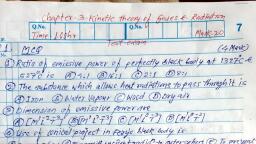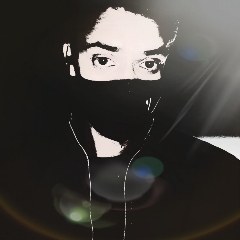Question 1 :
In physics, the mean free path is the average distance traveled by a moving particle (such as an atom , a molecule, a photon) between successive impacts (collisions), which modify its direction or energy or other particle properties. In which of the following mean free path is used ?
Question 2 :
State whether true or false.<br/>The arrangement of particles in a liquid is less ordered compared to solids. However, there is no order in the arrangement of particles in the gaseous state.<br/>
Question 3 :
Pressure of an ideal gas is increased by keeping temperature constant. What is effect on kinetic energy of molecules?
Question 4 :
Assertion: Rate of diffusion of a gas is inversely proportional to the square rate of its density
Reason: Hydrogen is the lightest gas known. so it diffuses most readily
Question 5 :
If we heat the particle at one end of a material,
Question 6 :
From what minimum height, a block of ice has<b> </b>to be dropped in order that it may melt completely on hitting the ground :<br/>
Question 7 :
A gas has an average speed of 10 m/s and a collision frequency of 10 $s^{-1}$. What is its mean free path?<br>
Question 8 :
<p>Three closed vessels A, B and C are at the same temperature T and contain gases which obey Maxwell distribution law of velocities. Vessel A contains $O_2$, B only $N_2$ and C mixture of equal quantities of $O_2$ and $N_2$. If the average speed of $O_2$ molecules in vessel A is $V_1$ and that of $N_1$ molecules in vessel B is $V_2$, then the average speed of the $O_2$ molecules in vessel C is</p><p></p><p></p><p></p><p></p><p></p><p></p><p></p><p></p>
Question 9 :
<p class="wysiwyg-text-align-left">Select the correct formula :</p><p class="wysiwyg-text-align-left">(where k=Boltzmann's constant, R= gas constant, n= moles, r = density, M= molecular weight, p= pressure, T= kelvin temperature, V= volume)<br/></p><p class="wysiwyg-text-align-left">a) k=RN$_{av}$ </p><p class="wysiwyg-text-align-left">b)$r=\dfrac{nM}{V}$</p><p class="wysiwyg-text-align-left">c)$\dfrac{p}{r}=\dfrac{RT}{M}$</p><p class="wysiwyg-text-align-left">d) R=kN$_{av}$</p>
Question 11 :
Which of the following is/are true on the basis of kinetic theory of matter?<br/><br/>
Question 12 :
A molecule of gas in a container hits one wall (1) normally and rebounds back. It suffers no collision and hits the opposite wall (2) which is at an angle of $30^o$ with wall 1.<br>Assuming the collisions to be elastic and the small collision time to be the same for both the walls, the magnitude of average force by wall 2. $(F_2)$ provided the molecule during collision satisfy<br>
Question 13 :
With increases of temperature, the vibration volume in any substance _____
Question 14 :
The average kinetic energy of the particles of a gas is most closely associated with which of the following quantity? <br/>
Question 15 :
<p class="wysiwyg-text-align-left">If the volume of the gas is to be increased by 4 times :</p>
Question 16 :
$2$ mole ideal He gas and $3$ mole ideal $H_2$ gas at constant volume find out $C_v$ of mixture
Question 18 :
State whether True or False, and correct the statements if false:<br>(i) the molecules of solids are tightly packed.
Question 19 :
The internal energy of a diatomic gas us given as $U=U_0V$, where $U_0$ is a constant . Molar heat capacity of gas is
Question 20 :
________ is the transfer of heat from are location to another in the absence of any material flow.
Question 22 :
<p class="wysiwyg-text-align-left">A ballon filled with air at 47$^{0}$C has volume of 3 litre. If ballon is kept in a room its volume becomes 2.7 litre, the temperature of the room is :<br/></p>
Question 23 :
The value of C$_v$ for 1 mol of polyatomic gas is (F $=$ number of degrees of freedom) :
Question 24 :
The gas law $\left [ \dfrac{PV}{T} \right ]=$ constant is true for<br/>
Question 25 :
Which one of the following is not an assumption of kinetic theory of gases?
Question 26 :
<p class="wysiwyg-text-align-left">The temperature at which the volume of ideal gas is zero is:</p>
Question 27 :
If for a gas $\dfrac{R}{C_{v}}=0.67$, then the gas is made up of molecules which are :<br/>
Question 28 :
The deviation of gases from the behaviour of ideal gas is due to :
Question 29 :
The mean kinetic energy of a perfect mono atomic gas molecule at the temperature $T^{o}K$ is :
Question 30 :
<p class="wysiwyg-text-align-left">For perfect gas, the ratio of volume coefficient of expansion to pressure coefficient is :<br/></p>
Question 31 :
If the pressure in a closed vessel is reduced by drawing out some gas, the mean-free path of molecules :
Question 32 :
The mean free path of a gas varies with absolute temperature as :
Question 33 :
Which of the following property is used to identify whether a substance is a solid, liquid or gas ?
Question 34 :
<p class="wysiwyg-text-align-left">16 gm of $O_{2}$ gas and x gm of $H_{2}$ gas occupy the same volume at the same temperature and pressure. Then x is :<br/></p>
Question 35 :
A polyatomic gas with n degrees of freedom has a mean energy per molecules given by :
Question 36 :
If the value of R = 2/5 C$_v$ for a gas, then the atomicity of the gas will be:
Question 37 :
In Rutherford alpha particles scattering experiment, thin layer of which metal was used?
Question 41 :
The amount of heat required to heat 1 mol of a monoatomic gas from 200$^o$C to 250$^o$C will be ............. if the heat required to heat the diatomic gas from 200$^o$C to 300$^o$C is Q.
Question 42 :
<p class="wysiwyg-text-align-left">A sample of $O_{2}$ gas and a sample of hydrogen gas both have the same no. of moles, the same volume and same pressure. Assuming them to be perfect gases, the ratio of temperature of oxygen gas to the temperature of hydrogen gas is :<br/></p>
Question 44 :
The nature of the graph of pressure 'P' against reciprocal of volume 'V' of an ideal gas at constant temperature is 
Question 45 :
The number of degrees of freedom in an oxygen molecule is
Question 46 :
At what temperature will the kinetic energy of gas molecules be double of its value at 27$^o$C?
Question 47 :
<p class="wysiwyg-text-align-left">A gas at temperature 27$^{0}$C and pressure 30 atmospheres is allowed to expand to one atmospheric pressure. If the volume becomes 10 times its initial volumes, the final temperature becomes :<br/></p>
Question 48 :
The mean free path of a gas varies with absolute temperature as :
Question 49 :
<p class="wysiwyg-text-align-left">According to Boyle's Law PV=C the value of C depends on :<br/></p><p>a) Mass of the gas</p><p>b) Type of gas</p><p>c) Temperature</p>





















